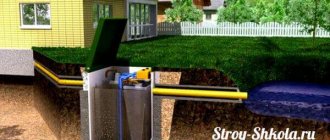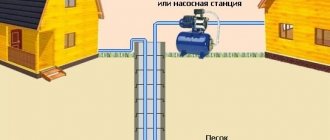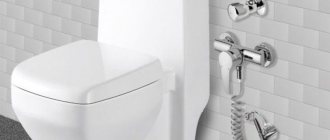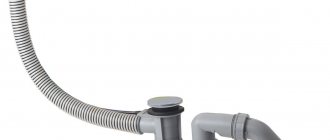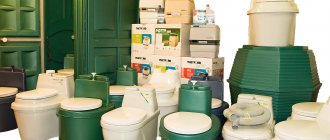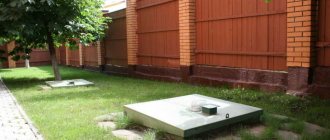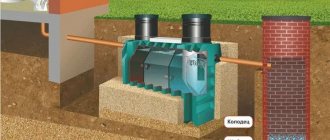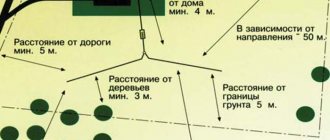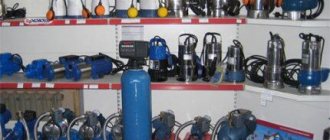Kikimora
10955 0 0
Kikimora August 5, 2016Speciality: I love my home, I like to equip it, periodically change something, do it with my own hands. There are no special hobbies. I am the administrator of a small women's forum.
Country toilet
In our house, like everyone else in the area, the problem of recycling sewage is solved simply: it flows into a shambo - a cesspool without a bottom. Since all the plots are quite large, and the drinking water supply is centralized, there are no problems with space for the pit.
Our city friends also decided to make a comfortable toilet in their country house, which they go to all year round and suffer from the lack of usual amenities. Especially when it’s night, frost or bad weather outside.
And then the question arose before them: where to place such a pit in a small area? After all, there is a water well right there, and vegetables and fruits grow, for which such a neighborhood is contraindicated. And burying a sealed container in the ground means calling a sewer truck every month, which is very expensive (considering the remoteness of the site from civilization), and in winter it is simply impossible.
Requirements for toilets in the country
In order for the toilet in the country to become not only a beautiful and comfortable place, but also meet the standards and requirements, before installing it, it is necessary to take into account SNiPs and SanPiNs.
The building codes and rules that regulate the requirements for toilets in the country are set out in No. 30-02-97 in two paragraphs:
- Clause 8.7 of SNiP - if there is no central sewerage system, then dry toilets and powder closets can be used in the areas. It is also not prohibited to install cesspools (backlash-closet) and outhouse latrines in the country.
- Clause 8.8 of SNiP - collection and disposal of waste is possible in a drainage trench, no closer than 4 m from the adjacent fence, or, with the permission of the SES, along an organized ditch into an external ditch.
The same SNiP explains the meaning of the terms for various country toilets:
- composting toilet - a system for processing waste through oxidation during heating or chemical treatment into organic fertilizer;
- backlash closet - a toilet with backlash ventilation in the house; feces, when flushed through the pipe, pass into the external cesspool;
- powder-closet - a toilet in a country house, where waste products are treated with peat or powder and stored in bulk form in an insulated box until completely composted;
- an outhouse is a lightweight building above a cesspool.
These standards are the same for dacha plots throughout the country, but each region, due to climatic and topographic features, has its own control system, with which it is necessary to coordinate actions when installing a toilet on the plot.
Attention! When installing a toilet in a country house, you must remember that it is forbidden to install backlash toilets in the 4th climatic and 3rd “B” subdistricts.
In addition to SNiPs, the safety and environmental friendliness of toilets in a dacha are regulated by sanitary rules 42-128-4690-88, for failure to comply with which a dacha resident can be fined up to 5 thousand rubles. The main points outlined in this paragraph are as follows:
- mandatory sealing of the cesspool;
- 3 m – maximum depth of the cesspool;
- contact of the cesspool with groundwater should not be allowed;
- cleaning the cesspool at least once every 6 months (or before reaching 350 mm of filling the container);
- All stages of water purification from septic tanks are mandatory.
Compliance with these requirements will save the owner of a summer cottage from fines and possible unpleasant litigation with neighbors and municipal services.
Dry toilet
A modern option for arranging a toilet inside the house is a bucket-composting toilet. Its capacity is 2 liters.
A special mass containing bacteria capable of dissolving biological waste must be periodically poured inside.
These dry toilets are quite affordable and do not emit a specific aroma around. Waste dissolved by bacteria serves as additional organic fertilizer.
Options for toilets in the country
Having dealt with the permitting requirements for a latrine on a site, you can determine which type of comfortable toilet in a dacha best meets the requirements and wishes of the site owner.
The choice of toilet is determined by the frequency of visits to the country estate and the number of people who will use it. Depending on the type of device, a toilet for a summer house can be located not only on the street, but also in the summer resident’s premises. Each of the toilet options has its own advantages and nuances, which you should familiarize yourself with before making your final choice.
Outdoor types of toilets for summer cottages
One of the most common types of toilets in the countryside is still an ordinary lightweight separate outdoor house.
Such birdhouse toilets in the country are convenient because they are located at a distance from the home and do not bother people with the unpleasant smell of waste.
Simple designs are economical; often when arranging them, a summer resident makes do with available materials or minimal investments. Installation and installation of a lightweight outdoor toilet in a country house is quite simple. You can choose a booth of any shape as the upper part of the structure.
Many carpentry shops and gardening stores offer free access to toilet options for summer cottages, from simple wooden ones to beautiful carved houses.
Various resources are used as material for arranging an outdoor toilet at the request of the owner of the site.
Depending on the type of waste accumulation, outdoor toilets in the country can be with or without a cesspool (powder-closet).
Outdoor toilet with cesspool
In addition to the above-ground part of the toilet in a country house with a cesspool, the hidden from view but important underground part of the outhouse is also carefully thought out. The cesspool must meet sanitary requirements. To do this, various methods of hermetically arranging it are used to prevent the spread of helminths and contamination of the soil:
- rubber tires or concrete rings;
- solid cement or brick tank;
- plastic container.
As the cesspool is filled with waste, it is cleaned using a sewer truck, which should be able to drive up and extend a hose to the toilet in the country.
To ensure that unpleasant odors escape from the outdoor toilet stall and are not absorbed into the walls of the house, a hole is provided above head level or a simple ventilation pipe is installed.
This type of outdoor birdhouse-toilet in a country house is suitable for any number of people and only requires pumping out waste as the cesspool fills.
Street powder closet in the country
In terms of external features, there is practically no difference between a street toilet with a cesspool and a powder closet. The difference between these types of latrines is the method of collecting feces. The powder closet does not have a large hole under the house and, as a result, there is no need to call a sewer truck to pump out sewage. Instead of a large cesspool, a compact container is installed, which, as it is filled, is emptied into a compost pit at the dacha. This becomes possible by sprinkling the waste with peat, sawdust or powder after each visit to the house. To do this, the cabin of an outdoor powder closet must be equipped with a sealed tank for collecting feces and a container with peat or small sawdust.
A tank for collecting feces is installed under the toilet seat; its volume, as a rule, does not exceed 10-15 liters. It is easy for one person to take such a container to the compost pit as it is filled. A container with peat or sawdust is placed in the toilet stall so that after defecation, waste can be sprinkled with its contents through the hole in the toilet seat.
Thus, each time the waste is powdered with sawdust or a peat mixture, which reduces the foul odor, and most importantly, helps turn feces into compost. This device allows the use of feces powdered with peat after complete composting as a feed for plants in the country due to the fact that decomposition occurs without chemical exposure. In order for the fecal-peat mixture to quickly become suitable for fertilizer after being thrown into a compost pit, summer residents often use additional preparations.
Advice! The drug "Biocompostin" reduces the natural formation of compost in the general heap from 3 to 1 year.
In the house, in addition to tanks for waste and powder, a ventilation pipe and a door for removing the tank are formed, if the plane of the toilet seat is built into the overall structure of the house.
An outdoor powder closet, like a budget cesspool, is easy to install, but is not designed for a large number of people in the country due to the small storage tank and the long period of waste decomposition.
Home types of toilets for the garden
There are types of country toilets, the design and waste collection of which allows them to be placed in a residential building. This allows you to relieve yourself without leaving your home, even if there is no central sewage system at your dacha.
Dry toilet
A dry toilet involves the complete recycling of waste by exposing it to chemicals or electricity. The operating principle of a chemical dry toilet is simple. The upper reservoir contains water, which, when flushed with waste along with feces, enters the lower storage tank, interacting with chemicals until the waste products are completely decomposed.
There is a valve in the lower container that retains unpleasant odors and prevents them from spreading into the toilet. When the tank with processed waste is full, it is disconnected from the general structure and taken out to dispose of the final residues. After emptying the lower container, it is washed and chemicals are added.
When pouring chemicals, different types of substances are used:
- Formaldehyde is the most effective and fast-acting preparation. The high toxicity of chemicals forces the final disposal of residues to be carried out away from plantings, and best of all into the central sewer system.
- Ammonium - break down waste in 5-7 days, working without access of oxygen to the container. A more gentle way of breaking down waste, which allows its reuse in the compost pit of the dacha.
- Biological - a selected composition of living bacteria that turns feces in the receiver into fertilizer. The drugs are absolutely safe for humans and the environment, but are expensive.
Many modern models of chemical portable toilets have a tank full sensor, which indicates that it is time to empty the tank.
This type of toilet in a country house is convenient if it is used by a small number of people. As a rule, if the device is visited by only one person, then it will have to be emptied no more than twice a month. If a family of 2-3 people uses the toilet - once a week, or even more often.
Electric dry toilets in the country look like a regular toilet. They are installed next to the outlet for connecting the ventilation system and compressor.
The electricity consumption of such a device is small - it is equivalent to the operation of a regular light bulb.
The operating principle of an electric dry closet in a country house comes down to separating waste into liquid and solid. Liquid waste, passing through the hose, enters the prepared drainage, and solid waste is dried by a compressor to a powder state. They are dried until flour is concentrated in a special toilet tank, then they can be used to fertilize plants in the country.
Despite the compactness and aesthetic appearance of the electric toilet in the country, it has a number of disadvantages that must be taken into account before installation:
- connection to the presence of light in the country - if the electricity is turned off, the toilet stops working;
- the need to arrange a drainage tank on the street;
- high cost of the main unit.
Backlash closet
The construction of a backlash closet at the dacha consists of two parts: the toilet seat is located indoors, and the feces collection is located outdoors.
This is an improved design of an outdoor cesspool toilet-birdhouse and a toilet in a home-type toilet. A backlash closet can look like a familiar city toilet - a flush toilet, a washbasin.
The arrangement and decoration of the toilet room does not require any special requirements, with the exception of good ventilation of the room. To do this, it is advisable to install, in addition to the room window, a forced system based on an exhaust propeller.
The entire main sewer system is underground.
A pipe 60-70 cm long and at least 110-150 cm in diameter is installed from the toilet into the external cesspool. It should not rest against the bottom of the cesspool and be strictly vertical to prevent clogging and stagnation of feces in the toilet. The cesspool itself extends 0.8 -1 m under the toilet room and in this place is about a meter deep.
The main volume of the tank, which is located underground next to the house, is determined based on the number of people. The calculation is made as follows: about 1 square meter is allocated for one regular visitor to the dacha. m. Near the cesspool area under the toilet itself, a slope is made away from the toilet, reaching a depth of 2 m. Along the perimeter, the dimensions of the main pit are approximately 3 by 3 m.
Be sure to provide a hatch through which sewage is pumped out using a sewage machine. The toilet tank is cleaned when the level does not reach the top by 50 cm.
To prevent gases from accumulating in an underground reservoir, when building such a toilet in a country house, an exhaust hood is made - a backlash channel from the cesspool to the street. An exhaust pipe is installed at a distance of 30 cm from the ceiling, through which air from the cesspool flows outside. As a rule, for the backlash channel they use a pipe with a diameter of 150 by 150 mm and lead it half a meter above the smoke channel, covering it with a weather vane on top.
Important! All backlash channel connections must be sealed.
Peat dry toilet
The name itself suggests the use of peat when using this type of latrine. Biological waste is covered with peat, which is located in a special tank.
There is practically no smell, but it is recommended to equip the room with an exhaust hood.
The operation of this toilet is based on a very simple principle: waste products are covered with peat. After this, the liquid flows into the pit or accumulates in a special closed container.
Solid waste can be used as organic fertilizer. This option is called the Finnish toilet. Recently, it has become in demand among summer residents.
Which toilet in the country is better?
The choice of toilet in the country depends on many factors:
- number of people visiting the room;
- length of time spent at the dacha;
- budget;
- the presence of a residential building on the territory.
When living at the dacha will be permanent, including in the winter season, the outdoor toilet will be cold already at the first frost. If the dacha is a seasonal event, then a simple toilet-birdhouse is a good way out of the situation, especially since such a structure is located far from the house and eliminates the unpleasant odor. When constructing cesspools, whether they are home backlash closets or outdoor cubicles, it is necessary to ensure access for the sewer truck to the dacha.
If it is impossible to organize emptying of the cesspool, then the usual storage cesspool will have to be abandoned in favor of a powder closet or dry closet. This option is ideal when 1-2 people visit a summer cottage on weekends or watering days. Dry toilets with chemical waste treatment are convenient, do not require installation or preparatory work, but they complicate the choice due to their high cost.
Full bathroom
In terms of convenience, this is undoubtedly the best option, but it is also the most troublesome and expensive. Firstly, it is necessary to allocate a separate room in the house, and secondly, there is a need for certain communications. It is a regular toilet with a sewer line. Discharge can occur either into a regular cesspool or into a septic tank.
The pros and cons of a cesspool were discussed above. The advantages of a septic tank are that the waste in it is processed and no longer poses a danger to soil and water pollution. Also, unlike a pit, a septic tank does not require pumping, or this happens much less frequently.
It must be remembered that the bathroom inside the house requires heating, as the water supply units may freeze. Undoubtedly, all of the listed difficulties cannot be compared with the convenience and comfort of a full-fledged bathroom, even in a small country house.
Where is the best place to put a toilet in the country?
In order to choose the optimal location for the toilet in the country, you need to be guided not only by the wishes of the summer resident, common sense, but also by sanitary standards. The basic requirements of the sanitary and epidemiological station for the location of a toilet with a cesspool in a dacha are set out in SNiP 30-02-97:
- distance 12 m from residential buildings;
- being no closer than 1 m from the fence;
- proximity to wells and other sources of water 8 m.
It is worth remembering that these sanitary requirements must be met not only in relation to your own site, but also to the neighboring one.
Also an important factor in choosing a location is the direction of the wind, which, with an intense gust, can bring unpleasant odors to the house or veranda. When scavenging, a prerequisite for choosing a location must be the availability of equipment for pumping out toilet waste. The length of the hose from the machine barrel is approximately 7 m, of which only 4 m lie on the surface of the ground - the remaining 3 are in the cesspool during pumping.
If the toilet is not supposed to be pumped out at the dacha, then in compliance with all standards it can be placed in the corner of the site, with a beautiful path leading to it using stone or other decor.
Electric dry closet
This type of toilet needs to be connected to household communications systems. The operating principle of this device is based on the selection and drying of solid biological waste, and the liquid component is drained separately. Dry waste is transferred to a separate container, and a drain pit is sufficient to drain liquid waste.
The room must be equipped with ventilation.
An electrical device is used if it is impossible to organize a regular home bathroom with a toilet and water.
Original toilets for the dacha
Arrangement of a toilet in the country is not only compliance with rules and sanitary standards. This can become a very exciting activity if you add imagination and an interesting idea to the technical characteristics.
Even ordinary models of outdoor toilets become exclusive with the addition of a few original features.
The play of color and light gives the designs a new format.
The interior decoration of the toilet room can be done in the same style, which, with minimal furnishings, looks original and interesting. You can come up with your own version or implement a ready-made one, using pictures of the interiors of toilets for your dacha.
Plastic booth
A relatively simple solution to the waste disposal problem is a plastic toilet. For a dacha - quite a suitable option. It is durable, lightweight, resistant to external factors, and easy to keep clean.
Such bathrooms are arranged very simply: a cubicle with a door, a toilet seat installed inside, and under it a tank with a volume of 150 to 380 liters. Ventilation is required in such booths.
The main advantages of a plastic toilet for a summer residence are:
- ease and speed of installation;
- minimum effort to keep the toilet clean;
- resistance to external influences;
- Insulated cabins can be used at sub-zero temperatures.
But there are also disadvantages:
- the need to buy chemicals to break down waste;
- requires tank cleaning;
- simple cabins cannot be used in sub-zero temperatures.
Useful tips
Regardless of the chosen type and type of latrine, there are a number of useful tips that will greatly facilitate the process of arranging and further using the latrine and will help you create the best toilet in the country:
- Regardless of the location of the toilet - outdoor or indoor, it is necessary to carefully consider ventilation at the construction stage. This will get rid of the unpleasant odor that tends to linger and accumulate in the toilet room.
- When choosing material for pipes, it is better to give preference to polypropylene. It is known for its durability, its ability to withstand high temperatures that can occur due to heating.
- When using drugs that decompose waste in dry closets, you must act according to the instructions for the selected product. You should not save on cheap analogues and unknown manufacturers; it is better to choose proven products to avoid unexpected results.
- Installing a toilet cesspool in a dacha is possible without calling a sewer truck. When the tank is filled to three-quarters of its full volume, it is filled up and the cesspool with the toilet is moved to another place.
- When assessing the budget for a toilet for a summer residence, it is necessary to take into account the costs of further operation: payment for sewerage services, purchase of chemical and biological materials.
Regular classic closet
Even in the last century, the question of which toilet to choose for a summer house had a clear answer. The most popular among summer residents throughout the country were, undoubtedly, structures with cesspools. Today, many alternatives have appeared, but many dacha owners continue to use and build classic toilets on their plots.
Most often, the pit size is up to two cubic meters. The walls are laid out from available materials: brick, cinder block, etc. The bottom of the pit is arranged in two ways:
- Sealed. The bottom is filled with concrete. Due to the tightness of the container, groundwater is not contaminated. But such a pit will have to be cleaned more often.
- Drainage. The bottom is covered with gravel and sand. Drainage allows liquid to pass through, so it takes longer for the hole to fill. But there is a danger of groundwater contamination.
Price
The price of a septic tank depends on the volume and equipment. Here are some examples:
- "Cumulative". Different models have a volume from 1100 to 10 thousand liters. No equipment is provided. Cost - from 17 thousand to 59 thousand rubles.
- "Tver". Cost: from 64 thousand to 89 thousand rubles (various equipment available).
- "Tank". Septic tank with a volume of 1 cubic meter. m costs 20 thousand rubles, volume 2 cubic meters. m - 36 thousand rubles. (without equipment).
Here are the prices for various dry toilets:
- Thetford Qube 345. Dutch chemical toilet with a storage capacity of 12 liters. Costs 6155 rubles.
- Ecomatic. Finnish-made peat dry closet with a storage capacity of 110 liters. Cost - 25.5 thousand rubles.
Separett Willa 9011 (Sweden) - an electric composting toilet with a 23-liter storage container - costs 34.8 thousand rubles.
Reviews
Vitaly Valerievich Kovtun, 39 years old, Moscow region
I rarely go to the dacha, so I limited myself to buying a store-bought peat toilet. I built the booth from corrugated sheets. There are almost no odors. I store waste in the thickets of the garden for compost.
Stanislav Igorevich Deryuga, 49 years old, Voronezh
We spend summer holidays with our family at the dacha. The toilet was made of traditional wood. I dug a hole with a volume of 1.5 m3 and lined the walls with bricks. During a month of living, the tank fills up a little, but every 5 years I hire a suction pump to pump it out.
Features of construction
When the pit is ready, a frame for the cabin is made on top of it. The floor is being straightened and a toilet seat is being installed. In terms of the use of materials, the frame can be either wooden or metal. It can be sheathed with either planed boards, thick plywood, or plastic, slate, or corrugated sheets.
The roof is usually made of a pitched roof. But you can use other types of it, even flat. The rafter structure can be covered with any roofing material - from the cheapest (slate) to the most expensive (metal tiles, corrugated sheets).
Welding equipment at reasonable prices from the store mg.biz.uaWhat is fiber cement siding?
Secrets of a good harvest: what fertilizers should be applied to the plot in the fall
The nuances of installing a ceramic toilet
On the modern market of plumbing equipment, there is an assortment of classic earthenware toilets, similar to the models that are installed in home bathrooms of apartments and houses.
Advantages of ceramic products:
- ease of use;
- aesthetic appearance;
- products are easy to clean with cleaning agents;
- ceramics do not absorb unpleasant odors;
- Excellent for installation in unheated rooms.
Please note that a faience floor-standing toilet is heavy, so it is not suitable for installation on flooring made of wooden planks. Wood may not withstand heavy earthenware, which can lead to unpleasant consequences. This option is optimal for permanent structures with concrete floors.
Aesthetic ceramic toilets are characterized by a rather high price, in some cases they turn out to be more expensive than the building itself.
If you have chosen a faience toilet model, you need to build a reinforced concrete floor. This will ensure the reliability of the design, but will cost more
To install a ceramic toilet in a garden plot, the floor in the autonomous sanitary unit must be reinforced. Installing a heavy seat on a wooden floor is impractical. In terms of maintenance, earthenware products are practically no different from plastic ones. A ceramic garden toilet lasts longer, looks more expensive and more aesthetically pleasing.
Installing a traditional ceramic toilet does not require any special skills. A hole is made in the floor of the bathroom, the size of which must correspond to the internal diameter of the outlet of the earthenware toilet. It is recommended to reinforce it around the perimeter with beams on which the product will be installed.
Before installing a heavy ceramic garden toilet, it is advisable to strengthen the floor covering with beams. This will avoid unpleasant situations
A faience toilet for an outdoor country toilet is placed at the intended place of use and the mounting points are marked. After which it is removed, a hole is drilled according to the markings, and a layer of sealant is applied to the base of the surface. At the final stage, the toilet is installed, screwing it with bolts.

